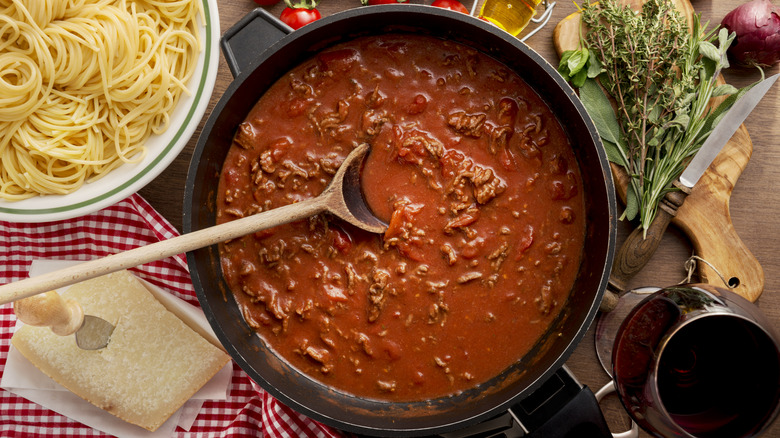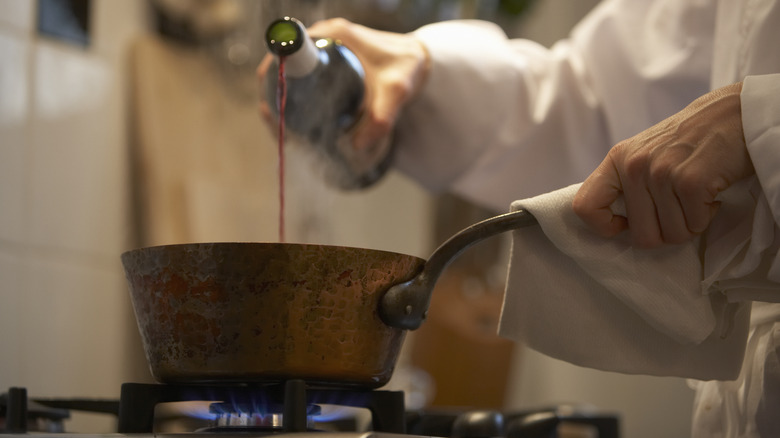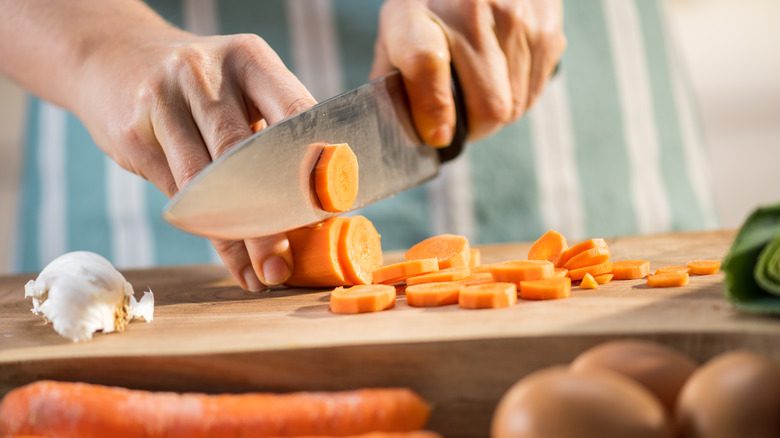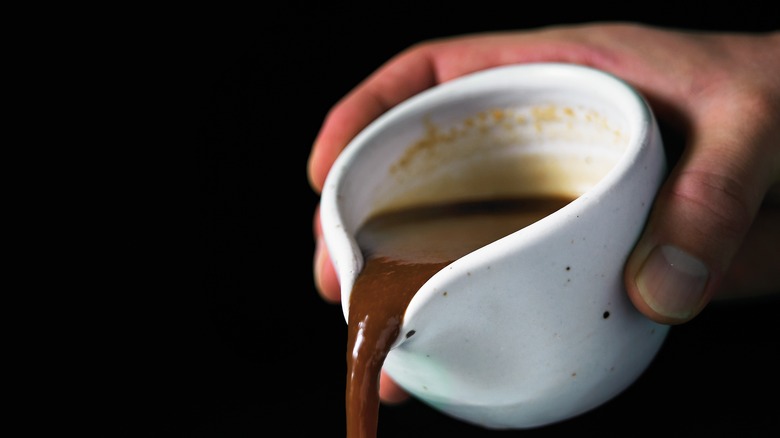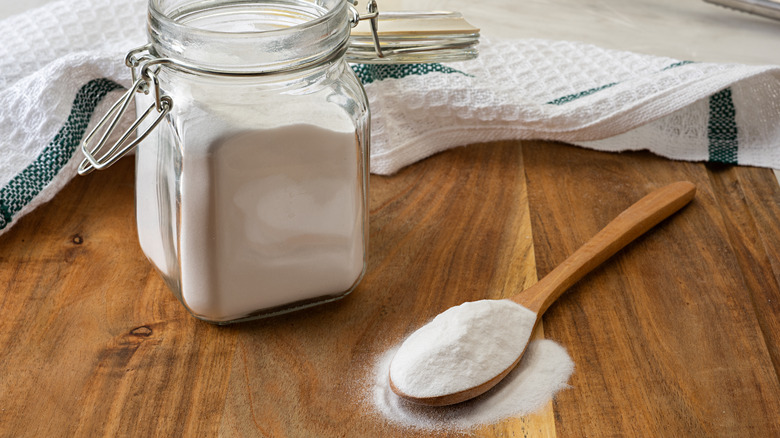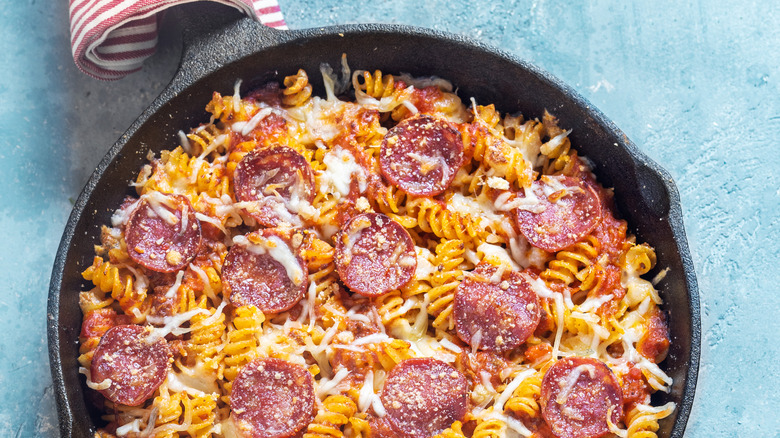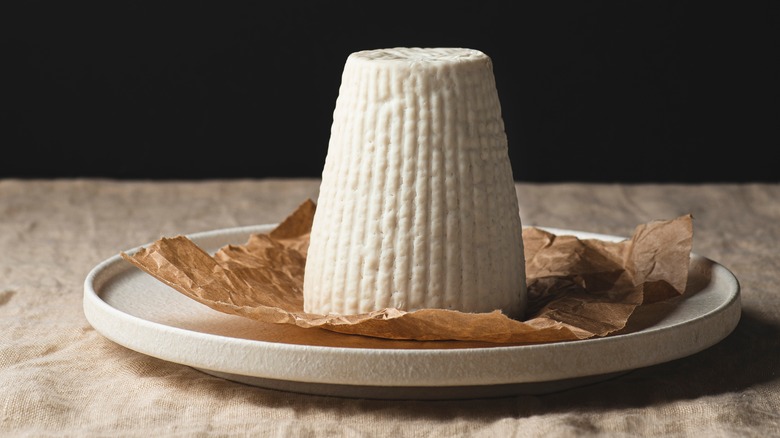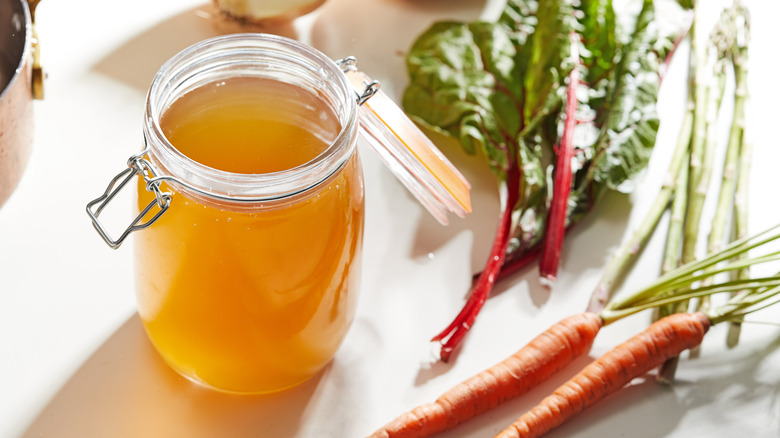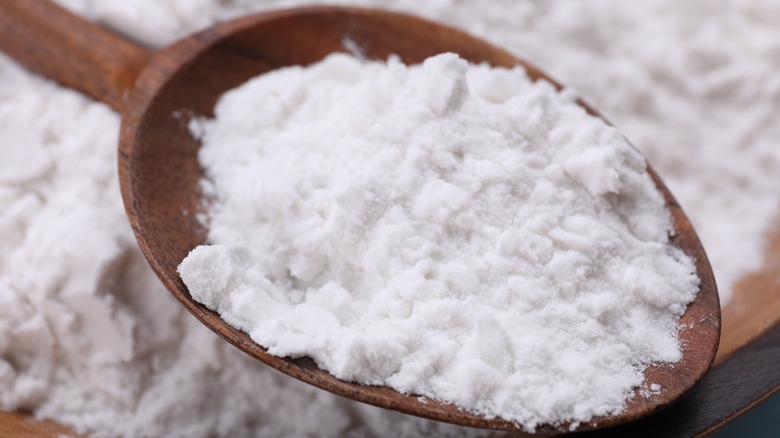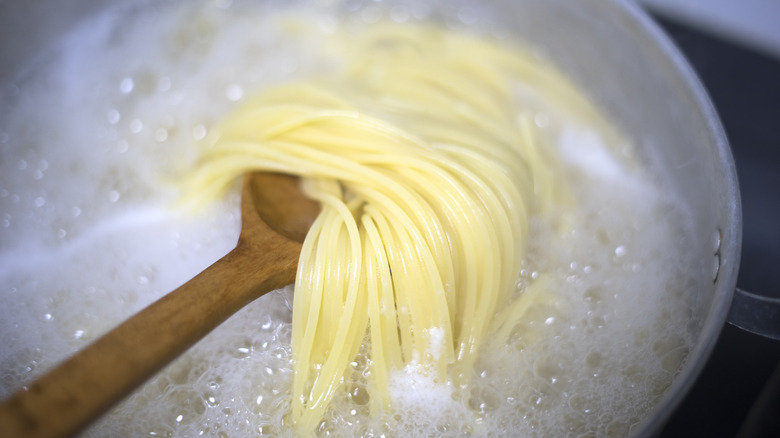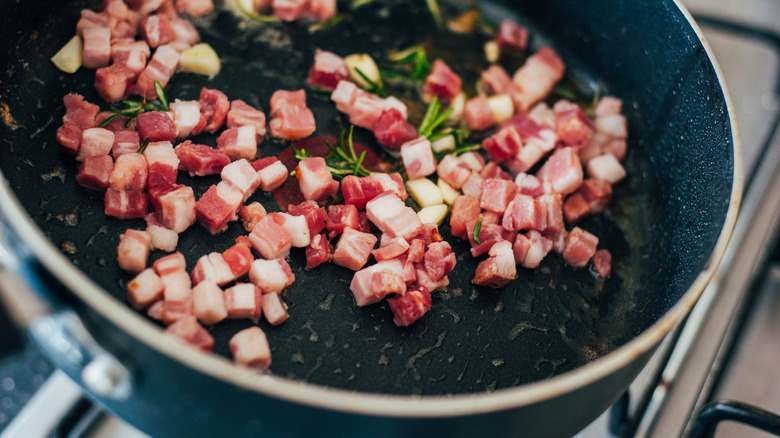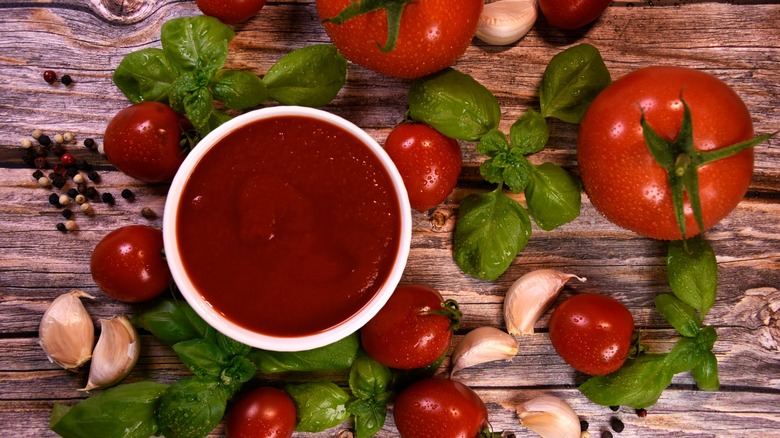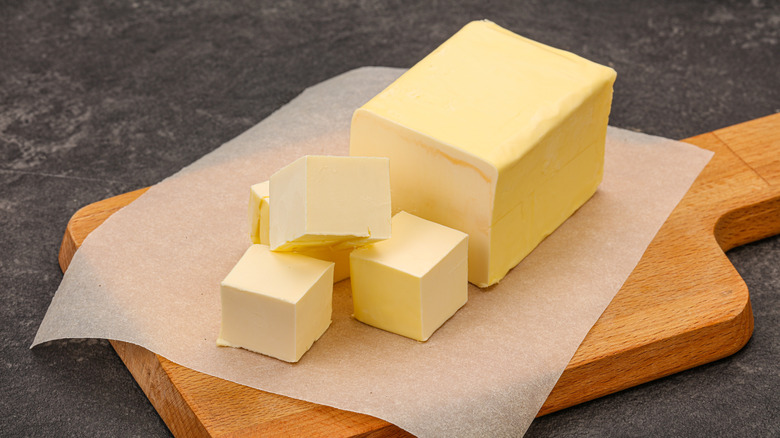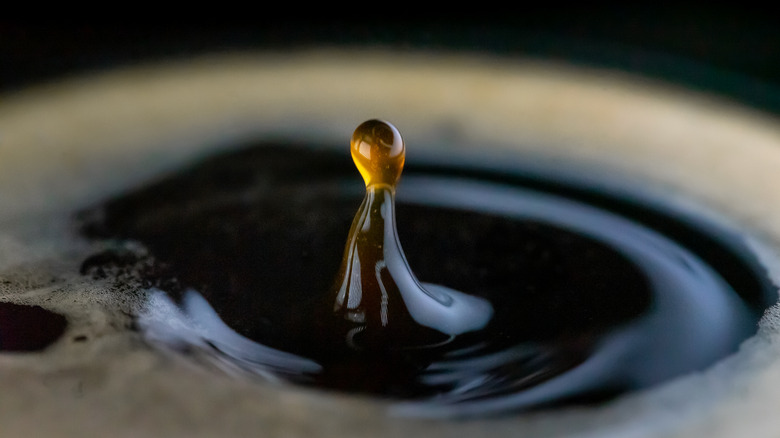Upgrades That Will Transform Your Plain Spaghetti Sauce
If you're looking for a way to upgrade plain spaghetti sauce, you're in the right place. While standard spaghetti sauce tastes well enough, traditional ingredients like tomato paste, Italian herbs, and garlic can get boring after a while. Thankfully, there are plenty of other ways to take your plain spaghetti sauce from drab to fab. Using ingredients you probably already have in your kitchen, you can change the taste, texture, or consistency of your sauce for the better. In this article, we're detailing all of the best ways to give your plain spaghetti sauce the ultimate boost. From unsuspecting pantry ingredients to caffeinated beverages, some of the upcoming spaghetti sauce upgrades might shock you.
Just be sure to add these ingredients wisely; though delicious, some of these ingredients require that you follow specific instructions to keep your pasta delicious — and safe. Join us as we reveal the ultimate list of ingredients you can use to elevate the flavor of plain spaghetti sauce.
Red wine
Using red wine is a sophisticated way to upgrade plain spaghetti sauce. The alcohol in the wine works to break down the fat in the sauce while accentuating the flavor of the ingredients. How much red wine you use will depend on the recipe. Anne Burrell's pasta bolognese recipe, for example, features 3 cups of the stuff, while other recipes, like this quick and easy 30-minute pasta bolognese, requires only ½ cup of dry red wine.
To use red wine as an upgrade to plain spaghetti sauce, consider deglazing your pot with it after sautéing onions, garlic, and any veggies you might be using. Many recipes call for the wine to cook until it is reduced before moving on to the next steps. Don't want to use alcohol in your pasta sauce? There are many great substitutes for red wine you can use instead, including grape juice, cranberry juice, black tea, or even beef broth, as you'll see later.
Vegetables
Yes, plain spaghetti sauce already contains tomatoes (which are technically a fruit, by the way), but there are plenty of vegetables that you can add to your sauce to enhance its flavoring. Carrots, for example, add natural sweetness to pasta sauce that can sometimes eliminate the need for extra sugar. Celery is also a great addition, especially when combined with garlic and onion. In fact, this classic ragu alla bolognese recipe calls for the carrots, celery, and onions already mentioned, along with other vegetables like mushrooms to make one heck of a pasta dish.
Looking for a way to incorporate more spinach into your diet? Try adding it to your plain spaghetti sauce. This easy one-pot pasta recipe with spinach and tomatoes combines nutritious spinach with parmesan and other delectable ingredients for an easy weeknight meal chock full of healthy goodness. Zucchini, kale, and bell peppers are also awesome additions that add their own distinct flavor. Worried your kids won't eat veggie-infused spaghetti sauce? No worries. Simply sauté any veggies that need softening before sticking them in a blender along with your tomato base and give it a whirl. The veggies will disappear into the sauce, and your kiddos won't even notice a difference. In fact, because of the incredible flavor that veggies often bring to plain spaghetti sauce, they may like vegetable spaghetti sauce even more.
Worcestershire sauce
Worcestershire sauce works well as a plain spaghetti sauce enhancer. In case you aren't familiar with it, Worcestershire sauce is a condiment often made of vinegar, molasses, anchovies, and a few other ingredients. The result is a deliciously umami add-in that tastes particularly wonderful when paired with savory meals. Though you may not always come across classic spaghetti recipes that contain this condiment, Reddit has some surprising ideas about using this secret ingredient in pasta sauce, with many attesting that Worcestershire sauce indeed imparts amazing flavor.
To utilize Worcestershire sauce in plain spaghetti, simply douse it over your tomato base while adding your other seasoning ingredients. Be sure not to use too much; just a tablespoon or so will do. Though not required, you may also consider adding a smidge of sugar to your pasta with Worcestershire sauce, as doing so will help balance its deep umami flavors and cut through the bitterness of the tomatoes.
Baking soda
If you have a sensitive stomach, one of the easiest fixes for bitter tomato sauce is to add baking soda. Because baking soda is alkaline, it helps cut the acidity of plain spaghetti sauce. Adding baking soda to plain spaghetti sauce can be safe as long as you don't overdo it. Consuming too much baking soda can prove poisonous and can have other adverse effects on your health that could lead to seizures, kidney failure, trouble breathing, dehydration, and more. To start, try using only ¼ teaspoon per 1 cup of sauce. Your sauce may even fizz a bit when you pour it in, but don't worry; it's normal.
Though adding baking soda to your plain spaghetti sauce won't typically alter its flavor, using more than the recommended amount just might. In our experience, the sauce will become sweeter or saltier when too much baking soda is added, and not in a good way. Add baking soda in the beginning and only small in amounts at a time, tasting as you go, to ensure the best results.
Pepperoni
Pepperoni is a fantastic addition to plain spaghetti sauce and can be used a variety of ways. Pepperoni can take the place of meat in spaghetti or can accompany the ground beef or sausage in your sauce, depending on what you'd prefer. The pepperoni adds a spicy yet savory element that serves as a welcome surprise to unsuspecting tastebuds. You also can add pepperoni to your plain spaghetti sauce by placing it directly in the sauce or layering it over the top. In this simple pepperoni pizza pasta bake, the pepperonis are slow-cooked with the rest of the ingredients before the rest of the dish is crowned with more cheese and additional pepperonis at the end. You could also consider making a traditional baked spaghetti recipe and topping it with cheese and pepperoni to finish the dish.
When using pepperonis in spaghetti, feel free to let your creativity shine. Add pepperoni, meatballs, and heck, even your spaghetti sauce and noodles to pizza crust in this spaghetti and meatballs pizza recipe , or come up with your own creation. Our personal favorite way to use pepperonis in spaghetti is to replicate the flavor of a supreme pizza within the pasta itself. Simply add pizza sauce, bell peppers, sausage, onion, mushrooms, and of course, pepperoni, to the mix to enjoy pasta that tastes as close to pizza as you can get.
Ricotta
Ricotta is typically associated with lasagna, but it can add incredible flavor and unique texture to plain spaghetti sauce as well. A byproduct of cheesemaking, ricotta is known for its mild flavor and distinctly thick and gritty texture. Certain spaghetti recipes may already call for this non-traditional ingredient, including this slow cooker spaghetti casserole, where you'll benefit from the spicy savor of pepperonis while enjoying the luxurious richness of ricotta, as well. And though this recipe calls for 2 cups of ricotta cheese added at the end, you may not need to add quite that much to your next batch of spaghetti.
A little at a time will do, depending on the look, taste, and texture you're going for. Be advised that because of its richness, ricotta cheese can sometimes mask the flavor of the other spices used, so it may be necessary to adjust the seasonings in your plain spaghetti sauce after adding it.
Broth or stock
Adding broth to your plain spaghetti sauce can enhance its flavor, though you'll need to use caution when trying this upgrade. Beef or chicken stock will make your pasta sauce taste meatier, but may also detract from its traditional bright tomatoey flavor profile. Note also that adding broth to your spaghetti sauce may require that you cut back on salt. Since broths and stocks tend to contain sodium, you may end up with a dish that's too salty if you don't adjust your seasonings accordingly.
To add broth to your spaghetti sauce, start with only enough to thin out the consistency of your spaghetti sauce in the beginning. Remember that adding broth is like adding water in the sense that it could make your spaghetti sauce too watery if you add too much. By the way, you can also use broth to cook an easy one-pot spaghetti recipe, as is the case with this easy Instant Pot spaghetti recipe, perfect for busy evenings. The broth or stock acts as the liquid to help cook the noodles while simultaneously working as a flavor enhancer.
Cornstarch
Adding cornstarch to plain spaghetti sauce won't do much for its flavor, but it will totally upgrade its texture. Cornstarch can be added to spaghetti sauce to make it thicker, velvetier, and to help it cling to noodles better. And while it may seem simple enough to add cornstarch straight to your spaghetti sauce, doing so will lead to unappetizing white chunks in your pasta, and no one wants that.
To add cornstarch to your spaghetti sauce the proper way, you'll first want to make a "slurry." Combine water and cornstarch at a ratio of 2-to-1 and mix until smooth. Pour this mixture into your spaghetti sauce. Allow the sauce to simmer until thickened. The amount of cornstarch you'll need to use will depend on how much spaghetti sauce you have. We'd recommend starting with 1 tablespoon of cornstarch per cup of spaghetti sauce, however, if you only want your pasta sauce slightly thicker or only wish to help your sauce cling to noodles better, using as little as a couple of teaspoons per batch of spaghetti may work. Experiment and adjust the amount according to your needs and the amount of spaghetti sauce you plant to cook.
Pasta water
This one might sound a little weird, but adding the water you cooked your noodles in to plain spaghetti sauce can drastically enhance its taste and flavor. The starch from the noodles works to thicken the sauce, while the saltiness of the water provides additional seasoning. To use pasta water as an upgrade to plain spaghetti sauce, first boil your noodles in a separate pot of water. Once your noodles finish cooking, ladle some of that pasta water into your sauce to achieve a thicker, smoother, and more delicious-tasting spaghetti sauce.
One thing to note is that though the salt in your pasta water may boost the taste of your spaghetti sauce, it may also cause your spaghetti sauce to become too salty. If you salt your spaghetti sauce in the beginning, adding more salt to it through the addition of pasta water may ruin it. Because of this, it might be wisest to wait until after you add your pasta water to season your spaghetti sauce. Also, make sure not to add too much pasta water to your sauce. We'd recommend adding only about ¼ cup (or less) at a time to prevent it from becoming too watery.
Pancetta (or bacon)
Pancetta is an ingredient often found in pasta bolognese but can just as easily be added to traditional spaghetti sauce. Pancetta is salted pork that comes from the belly of a pig, and its taste is very similar to bacon. Pancetta tends to be extremely flavorful, though, if you don't want to make a special purchase, a few slices of bacon will do. To use pancetta or bacon to upgrade plain spaghetti sauce, simply dice it up and fry it in a pan until it renders fat. To the same pot, add any vegetables you may be using (think onions, bell peppers, carrots, or celery) along with aromatics like minced garlic toward the end. Sauté the veggies, allowing the fat from the pork to soften them while infusing rich flavor that will also permeate your sauce.
If you find that your pancetta or bacon renders too much fat, be sure to drain any excess. If you aren't sure, or if you're spaghetti sauce ends up with puddles of grease on top, skim off the fat with a spoon during the cooking process or wait until the sauce cools and remove any extraneous fat using a spoon or spatula.
Ketchup
Using ketchup in plain spaghetti sauce might not sound like much of an upgrade, and honestly, if you don't do it correctly, it really could negatively affect your dish. Like with sugar, ketchup can work to balance the acidity of spaghetti bolognese and other pasta sauce types. It also works a bit like tomato paste, though using it in place of tomato paste will definitely make your spaghetti sweeter. To prevent ketchup from producing a cloyingly sweet taste in plain spaghetti sauce, we'd recommend only adding a tablespoon of ketchup to the sauce at a time, tasting along the way.
Also, if you tend to add sugar to plain spaghetti sauce, you may want to omit it when using ketchup. Using ketchup and sugar together may cause it to become too sweet. Another idea is to try using the Worcestershire sauce mentioned earlier at a 1-to-1 ratio with ketchup, as the combo tends to produce a savory-sweet flavor that you just might love. And because we understand that this suggestion veers far from anything that'd be considered authentically Italian, we'd ask that you approach adding ketchup to your sauce with caution. You'll likely either love (or hate) the results.
Butter or olive oil
Adding a knob of butter to plain spaghetti sauce can improve its consistency and also elevate its flavor in a surprising way. Though not traditionally associated with spaghetti, butter contains fats that meld with your sauce, making it silkier, more luxurious, and, you guessed it, better able to adhere to noodles. It isn't only butter that works well in spaghetti sauce for these purposes; olive oil is another option that provides similar benefits. Adding a bit of fat in the form of butter or olive oil also helps combat watery pasta sauce.
When adding butter to your spaghetti sauce, do so right at the end for a beautiful glossy look. Dropping butter in too soon may cause it to separate and thus produce less appealing results. As far as adding olive oil goes, it might be best to toss your noodles in the oil before adding the noodles to the sauce.
Coffee
Adding coffee to plain spaghetti sauce sounds a bit scandalous, doesn't it? This seemingly ridiculous addition to spaghetti sauce apparently helps balance sweetness with its bitter and acidic characteristics in a way similar to cocoa powder in chili (yep, it's a thing). So, how's it done? Simply mix a teaspoon of instant coffee into water or broth before adding it to your spaghetti sauce. According to those who have tried it, it won't make your spaghetti taste like coffee, but will only accentuate its flavor. How much water or broth you use likely doesn't make a difference, although, as you might expect, how much liquid you use will affect the consistency of your spaghetti sauce.
The important thing is that you do not add too much coffee to your liquid — doing so will likely cause your spaghetti sauce to become too bitter. If you do find that you added too much coffee, you may be able to balance its acidic flavor with a bit of extra sugar, but in general, we recommend staying as modest as possible when it comes to using this secret ingredient.
